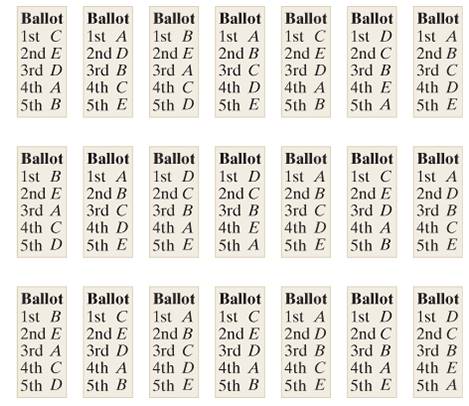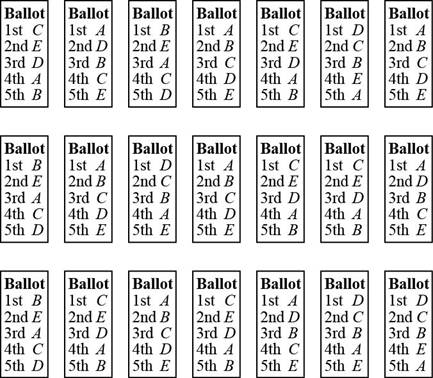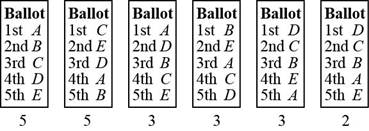
Concept explainers
Figure 1-8 shows the preference ballots for an election with 21 voters and 5 candidates. Write out the preference schedule for this election.

Figure 1-8
To find:
The preference schedule for the election with given preference ballots.
Answer to Problem 1E
Solution:
The preference schedule for the preference ballots for 21 voters and 5 candidates is,
| Number of Voters | 5 | 5 | 3 | 3 | 3 | 2 |
| 1st Choice | A | C | A | B | D | D |
| 2nd Choice | B | E | D | E | C | C |
| 3rd Choice | C | D | B | A | B | B |
| 4th Choice | D | A | C | C | E | A |
| 5th Choice | E | B | E | D | A | E |
Explanation of Solution
Given:
The preference ballots for 21 voters and 5 candidates are given as,

Calculation:
The ballots of the same preferences are grouped together as,

The preference schedule table for the above ballots is given by,
| Number of Voters | 5 | 5 | 3 | 3 | 3 | 2 |
| 1st Choice | A | C | A | B | D | D |
| 2nd Choice | B | E | D | E | C | C |
| 3rd Choice | C | D | B | A | B | B |
| 4th Choice | D | A | C | C | E | A |
| 5th Choice | E | B | E | D | A | E |
Conclusion:
The preference schedule for the preference ballots for 21 voters and 5 candidates is,
| Number of Voters | 5 | 5 | 3 | 3 | 3 | 2 |
| 1st Choice | A | C | A | B | D | D |
| 2nd Choice | B | E | D | E | C | C |
| 3rd Choice | C | D | B | A | B | B |
| 4th Choice | D | A | C | C | E | A |
| 5th Choice | E | B | E | D | A | E |
Want to see more full solutions like this?
Chapter 1 Solutions
MYLAB MATH FOR EXCURSIONS IN MATHEMATIC
Additional Math Textbook Solutions
Pathways To Math Literacy (looseleaf)
Precalculus: Mathematics for Calculus (Standalone Book)
Elementary Statistics ( 3rd International Edition ) Isbn:9781260092561
APPLIED STAT.IN BUS.+ECONOMICS
Finite Mathematics for Business, Economics, Life Sciences and Social Sciences
- A well-known company predominantly makes flat pack furniture for students. Variability with the automated machinery means the wood components are cut with a standard deviation in length of 0.45 mm. After they are cut the components are measured. If their length is more than 1.2 mm from the required length, the components are rejected. a) Calculate the percentage of components that get rejected. b) In a manufacturing run of 1000 units, how many are expected to be rejected? c) The company wishes to install more accurate equipment in order to reduce the rejection rate by one-half, using the same ±1.2mm rejection criterion. Calculate the maximum acceptable standard deviation of the new process.arrow_forwardFind the (exact) direction cosines and (rounded to 1 decimal place) direction angles of = (3,7,6)arrow_forwardShade the areas givenarrow_forward
- 5. Let X and Y be independent random variables and let the superscripts denote symmetrization (recall Sect. 3.6). Show that (X + Y) X+ys.arrow_forwardLet a = (-1, -2, -3) and 6 = (-4, 0, 1). Find the component of b onto a.arrow_forwardForces of 9 pounds and 15 pounds act on each other with an angle of 72°. The magnitude of the resultant force The resultant force has an angle of pounds. * with the 9 pound force. The resultant force has an angle of with the 15 pound force. It is best to calculate each angle separately and check by seeing if they add to 72°.arrow_forward
- 1. Sketch the following sets and determine which are domains: (a) |z−2+i| ≤ 1; - (c) Imz> 1; (e) 0≤ arg z≤ л/4 (z ± 0); Ans. (b), (c) are domains. (b) |2z+3| > 4; (d) Im z = 1; - (f) | z − 4| ≥ |z.arrow_forward8. Suppose that the moments of the random variable X are constant, that is, suppose that EX" =c for all n ≥ 1, for some constant c. Find the distribution of X.arrow_forward9. The concentration function of a random variable X is defined as Qx(h) = sup P(x ≤ X ≤x+h), h>0. Show that, if X and Y are independent random variables, then Qx+y (h) min{Qx(h). Qr (h)).arrow_forward
 Discrete Mathematics and Its Applications ( 8th I...MathISBN:9781259676512Author:Kenneth H RosenPublisher:McGraw-Hill Education
Discrete Mathematics and Its Applications ( 8th I...MathISBN:9781259676512Author:Kenneth H RosenPublisher:McGraw-Hill Education Mathematics for Elementary Teachers with Activiti...MathISBN:9780134392790Author:Beckmann, SybillaPublisher:PEARSON
Mathematics for Elementary Teachers with Activiti...MathISBN:9780134392790Author:Beckmann, SybillaPublisher:PEARSON
 Thinking Mathematically (7th Edition)MathISBN:9780134683713Author:Robert F. BlitzerPublisher:PEARSON
Thinking Mathematically (7th Edition)MathISBN:9780134683713Author:Robert F. BlitzerPublisher:PEARSON Discrete Mathematics With ApplicationsMathISBN:9781337694193Author:EPP, Susanna S.Publisher:Cengage Learning,
Discrete Mathematics With ApplicationsMathISBN:9781337694193Author:EPP, Susanna S.Publisher:Cengage Learning, Pathways To Math Literacy (looseleaf)MathISBN:9781259985607Author:David Sobecki Professor, Brian A. MercerPublisher:McGraw-Hill Education
Pathways To Math Literacy (looseleaf)MathISBN:9781259985607Author:David Sobecki Professor, Brian A. MercerPublisher:McGraw-Hill Education





